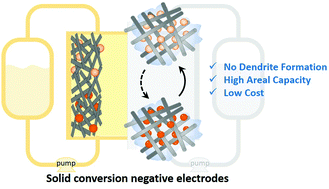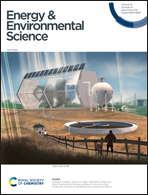High-areal-capacity conversion type iron-based hybrid redox flow batteries†
Abstract
Hybrid redox flow batteries (RFBs) offer a much higher energy density compared to all-liquid RFBs. However, the negative electrodes of hybrid RFBs normally utilize metal deposition reactions (e.g., zinc metal), which suffer from severe dendrite growth and poor long-term stability, especially at high areal capacities and high current densities. Herein, we propose and demonstrate the use of high-loading solid conversion electrodes to replace metal deposition electrodes to achieve high cycling stability at high areal capacities/current densities in hybrid RFBs. Using a Fe3O4/Fe(OH)2 conversion negative electrode as an example coupled with a Fe(CN)63−/Fe(CN)64− posolyte, we demonstrated conversion type all-iron hybrid RFBs with an unprecedentedly high cycling areal capacity of 126.6 mA h cm−2 at 50 mA cm−2 for 200 cycles (1000 hours) and 215 mA h cm−2 at 60 mA cm−2 for 100 cycles (700 hours) without capacity decay. The solid conversion electrode eliminates dendrite issues and the limitations of metal areal capacity, and demonstrates superior areal capacity, current density, and cycling stability compared to conventional zinc metal negative electrodes. This approach offers a new direction for developing high-energy, low-cost, and long-lasting hybrid RFBs for large-scale grid energy storage applications.



 Please wait while we load your content...
Please wait while we load your content...